To Vape or Not to Vape: E-Cigarettes Explored.
 To anyone who has followed the story of e-cigarettes bursting onto the market in the last decade, the research and reactions have seemed a jumble.
To anyone who has followed the story of e-cigarettes bursting onto the market in the last decade, the research and reactions have seemed a jumble.
The handheld electronic devices, which vaporize a flavored liquid containing nicotine, have been praised as effective quit-smoking tools, safer than conventional cigarettes.
They’ve also been slammed as a “gateway” to cigarettes for young adults, with studies showing they contain detectable levels of toxic chemicals.
The School of Public Health will wade into that debate on Wednesday, October 19, when two experts on electronic cigarettes share the stage at the 2016 William J. Bicknell Lecture. The event, titled “E-cigarettes: Good Idea? Bad Idea?” is free and open to the public.

Linda Bauld, a professor of health policy at the University of Stirling and deputy director of the UK Centre for Tobacco and Alcohol Studies, says that while e-cigarettes are not “risk-free,” they are an important alternative to “a uniquely deadly product that kills one in two of its regular users.” She says there is no “firm evidence” that e-cigarettes are a gateway to conventional cigarette use among young adults.

Andrea Villanti, director for regulatory science and policy at the Schroeder Institute for Tobacco Research and Policy Studies at Truth Initiative, agrees that the devices are effective quit-smoking aids, but says there is a need for “clear, accurate information” about their potential harms. She says vaping devices are “a diverse product class and must not be treated as a single product.”
The discussion comes in the wake of the Food and Drug Administration’s recent decision to extend its tobacco oversight authority to e-cigarettes. The controversial FDA regulations require manufacturers to detail what is in their products and apply for marketing permission by 2018.
Moderating the Bicknell event is Ronald Bayer, professor of socio-medical sciences at Columbia University Mailman School of Public Health, whose research focuses on issues of social justice and ethics related to tobacco and other health concerns. Bayer says he views the e-cigarette hand-wringing as “not just a scientific controversy—it’s also political.” He plans to explore why public health groups in the UK “have seen in the evidence a justification for enthusiastically embracing e-cigarettes as a harm-reduction strategy for smokers, while in the US, there has been deep skepticism, if not hostility, in the tobacco control community.”
According to data from the Centers for Disease Control and Prevention, 12.6 percent of adults had ever tried an e-cigarette in 2014. While only 3.2 percent of adults who had never smoked cigarettes tried them, the CDC and some public health advocates have been alarmed by a dramatic rise in use among teenagers.
SPH spoke to Bauld and Villanti about their views.
Proponents of strict regulations say e-cigarettes are a gateway to regular cigarette use, especially for young adults. Is that a worry or a fact?
Bauld: This may be a worry, but it is not an established fact. There is no firm evidence from anywhere—despite a couple of US and one Swiss study that followed up non-smokers who used e-cigarettes and found some of them had tried tobacco—that this is occurring. There are high rates of experimentation with e-cigarettes among teenagers in the US, and some evidence of this in the UK and other jurisdictions. However, regular use is confined to teenagers and young adults who already smoke tobacco.
Villanti: A primary goal of tobacco control is to keep all youth from using tobacco or nicotine products, and it’s important to know how new tobacco or nicotine products impact use among young users. While we have long-term population surveillance data on cigarettes in youth, we only have a few data points on e-cigarettes, as they are a relatively new product.
Cross-sectional data have shown declines in past 30-day youth cigarette use at the same time that there has been a rise in past 30-day youth e-cigarette use. In fact, the most recent data show that youth cigarette use is at an all-time low, which is encouraging. The data also indicate that past 30-day youth e-cigarette use did not increase significantly from 2014 to 2015 and may be leveling off. The largest proportion of youth e-cigarette use is infrequent, which is more consistent with experimentation than regular use.
Focusing only on the gateway between e-cigarette and cigarette use detracts from understanding the full picture of youth tobacco and nicotine use and its impact on public health.
Was the FDA right to regulate e-cigarettes as “tobacco products”? What’s your view of requiring companies to go through pre-market approvals?
Bauld: E-cigarettes are not tobacco products, and, in my view, a separate regulatory framework would have been more appropriate. However, I do appreciate the view of my FDA colleagues, which is that they wished to create a regulatory framework that includes all nicotine products. In the U.S., it is disappointing to see that Nicotine Replacement Therapy does not have a harm-reduction license to allow usage while cutting down on cigarette smoking or longer-term usage to avoid relapse to smoking. That needs to change.
I also appreciate the need for product standards of e-cigarettes and other vaping devices and am aware that the FDA regulations had this as one aim. However, the required pre-market approval process and the rather arbitrary cutoff for products already on the market that won’t need approval will, in my view, create advantages for tobacco and tobacco companies over independent e-cigarette manufacturers. This is a potential unintended consequence of the FDA regulations and will perpetuate smoking.
Villanti: The short answer is yes. If prudently regulated, e-cigarettes hold promise as one means to move smokers to a less harmful product and reduce the devastating death and disease burden caused by combustible tobacco products such as cigarettes, cigars or hookah.
Despite non-combustible tobacco and nicotine without tobacco being less toxic than combustible tobacco, e-cigarettes (and other new nicotine delivery devices) cannot fulfill any promise they may have of harm reduction if we do not know what is in them, who is manufacturing them, and how they are marketed and advertised. So, regulation is essential to ensure they are of good quality and as safe as possible, and that the benefits are maximized while harms are minimized.
Shouldn’t we applaud e-cigarettes as a smoking-cessation device?
Bauld: The evidence on smoking cessation with e-cigarettes is positive overall, although the quality of evidence remains weak. The update of the Cochrane review published earlier this year makes that clear. In the UK, we have a public health consensus statement endorsed by our main health charities, government agencies, and professional bodies. This makes clear that all the evidence suggests e-cigarettes are significantly less harmful than tobacco, and smokers should not be discouraged from using them. In addition, smokers choosing to use e-cigarettes can receive free support (counseling and the offer of additional, licensed stop-smoking medications) through our NHS smoking cessation services. Smokers who access these services and also use an e-cigarette have very good cessation rates.
Villanti: The great opportunity of e-cigarettes is that they have been adopted by large numbers of smokers. Current research suggests that e-cigarettes can increase quit attempts, reduce symptoms of nicotine withdrawal, prevent relapse, and potentially serve as a pathway to cessation of cigarettes. Further high-quality, randomized controlled trials and rigorous observational studies are important to confirm findings from the research to date.
Given the wide variety of products and ingredients, it is hard to know which specific e-cigarette products are most effective as cessation devices. We also do not know the quality or safety specifications of those products, as we do with cessation medications and nicotine replacement therapies that have been FDA-approved. Smokers seeking a pathway to quitting deserve a device that is effective and meets quality and safety standards.
If the biggest concern is youth starting to vape, what can be done to keep e-cigarettes away from kids?
Bauld: In the EU, the Tobacco Products Directive, which was introduced in May 2016, prohibits all broadcast advertising of e-cigarettes. In my own country, Scotland, further advertising restrictions (on billboards, free samples) will be introduced next year. Some limits on marketing are proportionate because of concerns about marketing to children, and age-of-sale laws are also in place in the UK. However, I believe some promotion is needed, particularly at the point of sale, to provide adult smokers with accurate information about these products and support switching. We can’t completely ignore the UK’s 8 million adult smokers because of fears about youth uptake. An appropriate balance has to be struck.
Villanti: A first step in preventing youth from starting to use tobacco or nicotine products was the FDA’s decision to bring all products under its authority. This provided youth access restrictions across all products, including cigars, hookah, and e-cigarettes. Minimum age of e-cigarette purchase enacted at the federal level, and enforcement of these laws by state and local agencies, will reduce youth access.
Our experience in tobacco control has identified other interventions, like advertising restrictions. A novel intervention would be to extend the ban on flavored cigarettes to all tobacco products, especially the most harmful combustible products. Other possible interventions include adopting standards that reduce the toxicity and addictiveness of products to the lowest possible levels; additional limits on youth access, like raising the nationwide minimum age of sale for tobacco to 21; or taxing products in proportion to their harms.
The Bicknell Lecture, named in memory of Dr. William Bicknell, founder and chair emeritus of the Department of Global Health, will be held 10 a.m. to noon on the Medical Campus in Hiebert Lounge. Live streaming will be available during the event.
Comments & Discussion
Boston University moderates comments to facilitate an informed, substantive, civil conversation. Abusive, profane, self-promotional, misleading, incoherent or off-topic comments will be rejected. Moderators are staffed during regular business hours (EST) and can only accept comments written in English. Statistics or facts must include a citation or a link to the citation.